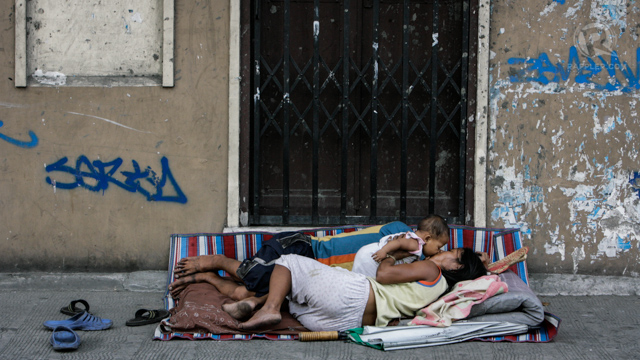SUMMARY
This is AI generated summarization, which may have errors. For context, always refer to the full article.

MANILA, Philippines – Many poor people in the Philippines are severely deprived of not only decent incomes but also access to health, education and decent standards of living.
Data released by the United Nations Development Programme (UNDP) at the Philippine launch of the Human Development Report (HDR) on Tuesday, March 26, showed that 47.4% of the poor experienced multidimensional poverty.
“Multidimensional poverty, this one is a different concept. This index recognizes that the suffering, the deprivation suffered by a poor person is usually not in one dimension. It could be in combination with other dimensions. It could be deprivation in health, deprivation in education, and access to other basic necessities including employment,” Socioeconomic Planning Secretary Arsenio M. Balisacan said in a presentation at the launch.
Data also showed that of the 3 deprivations, the poor who suffer multidimensional poverty, suffer from the deprivation to access to health the most. Deprivations to health contributes the most or around 56.5% to the overall poverty of the poor in country.
READ: The road to poor health in PH
The UNDP data showed that this is followed by the deprivation from decent living standards which account for 27.7% and access to education at 15.8%.
READ: ‘Low NAT scores may worsen under K to 12’
“The most important contributor to multidimensional poverty in the Philippines is health, deprivation in health,” Balisacan. “The conclusion we can show here is that although at present we still have some advantages relative to other countries in terms of the level of human development, but if we don’t get our acts together soon enough, we would lose all those advantages.”
Inequalities
The 2012 HDR also showed that if the country’s Human Development Index (HDI) score of 0.654 is adjusted to factor in inequality, the country’s rank declines to 0.524.
This represents a 19.9% overall loss in human development. The largest loss was in terms of the inequality in income at a 30% loss followed by a 15.2% loss due to inequality in life expectancy at birth and a 13.5% loss due to inequality in education.
READ: PH shows no improvement in HDI ranking
“The average HDI, as we have seen it, the value of HDI as potential human development whereas the actual may be lower because of prevailing or existing inequities and inequalities. So what these numbers did is to adjust for the inequality so that we could get a better sense of what the actual human development achievements are,” Balisacan explained.
“(This helps us see) the loss in human development, in potential human development. In other words, instead of 0.524, we could have achieved (a score thats) 20% higher if the distribution had become more equal, has been equitable,” he added.
The income inequality in the Philippines is one of the highest in the region. Based on the 2009 FIES data, the Gini coefficient of income was estimated at 0.4484 in 2009, slightly lower than the 2006 ratio of 0.4580 which indicates a more equal distribution of income in 2009.
READ: How much does a family need to stay out of poverty?
The Gini coefficient is a measure of income inequality within a population which ranges from 0 to 1, with 0 indicating perfect income equality among families, and 1 indicating absolute income inequality. – Rappler.com
Add a comment
How does this make you feel?
![[In This Economy] A counter-rejoinder in the economic charter change debate](https://www.rappler.com/tachyon/2024/04/TL-counter-rejoinder-apr-20-2024.jpg?resize=257%2C257&crop=267px%2C0px%2C720px%2C720px)
![[Vantage Point] Joey Salceda says 8% GDP growth attainable](https://www.rappler.com/tachyon/2024/04/tl-salceda-gdp-growth-04192024.jpg?resize=257%2C257&crop_strategy=attention)
![[ANALYSIS] A new advocacy in race to financial literacy](https://www.rappler.com/tachyon/2024/04/advocacy-race-financial-literacy-April-19-2024.jpg?resize=257%2C257&crop_strategy=attention)


There are no comments yet. Add your comment to start the conversation.